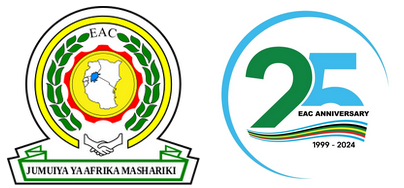United Republic of Tanzania
Tanzania hosts the EAC Headquarters. It is also the temporary seat of the East African Legislative Assembly (EALA) - the legislative Organ of the Community, and the East African Court of Justice (EACJ) - the judicial Organ of the Community. The country also hosts the East African Kiswahili Commission (EAKC).
The country includes the highest and lowest points in Africa - the summit of Mt Kilimanjaro (5,895 metres above sea level) and the floor of Lake Tanganyika (358 metres below sea level).
Key facts
Joined EAC: July 2000 (Founding Member)
Population: 54.2 million (2019 Statistics)
GDP: US$ 57.3 Billion (2019 Statistics)
Official language: Kiswahili, English
Timezone: GMT + 3hr
Currency: Tanzanian Shilling (Tsh)
Geography
Area: 945,090 sq. km
Coastline: 1,420 km (Indian Ocean)
Capital city: Dodoma
Population density (per sq. km): 53.5
The United Republic of Tanzania borders the Indian Ocean to the east, and has land borders with eight countries: (anti-clockwise from the north) Kenya, Uganda, Rwanda, Burundi, the Democratic Republic of Congo (across Lake Tanganyika), Zambia, Malawi and Mozambique. The country includes Zanzibar (consisting of the main island Unguja, plus Pemba and other smaller islands)
Languages
Kiswahili and English are the official languages.
Communications
Country code 255 (no area codes); internet domain ‘.tz’.
Public Holidays
New Year’s Day, Zanzibar Revolution Day (12 January, 1964), Sheikh Abeid Amani Karume Day (7 April, Zanzibar only), Union Day (26 April), Labour Day (1 May), Saba Saba (Industry Day, 7 July), Nane Nane (Farmers’ Day, 8 August), Nyerere Day (14 October), Republic Day (9 December), Christmas Day and Boxing Day.
Religious festivals whose dates vary from year to year include Prophet’s Birthday, Good Friday, Easter Monday, Eid al-Fitr (End of Ramadan, two days) and Eid al-Adha (Feast of the Sacrifice).
Transport
There are 90,810 km of roads, 15% paved.
There are also 2 railway systems, extending to a total of 4,460 km, and running on 2 different gauges. One links Dar es Salaam with central, western and northern Tanzania and Kenya (Tanzania Railways Corporation, gauge one metre, extending to 2,600 km); the other links Dar es Salaam to Zambia (Tanzania-Zambia Railways Authority, or Tazara).
The main ports are at Dar es Salaam, Mtwara, Tanga and Zanzibar. Regular boat services carry passengers and freight between Dar es Salaam and Zanzibar. Ferries provide freight and passenger transport on Lake Victoria.
There are 3 international airports (Dar es Salaam, Kilimanjaro and Zanzibar) and more than 50 local airports and airstrips. Because of the size of the country and scattered population, air services have become the most significant form of internal transport for official and business travel.
International relations
United Republic of Tanzania is a member of the African, Caribbean and Pacific Group of States, African Union, The Commonwealth, Indian Ocean Rim Association, Non-Aligned Movement, Southern African Development Community, United Nations and World Trade Organization.
Topography
The country comprises several distinct zones: a fertile coastal belt; the Masai Steppe and mountain ranges to the north (with Mt Kilimanjaro rising to 5,895 metres); and a high plateau in the central and southern regions. There are over 61,000 sq. km of inland water. Unguja Island (36 km from the mainland) is fertile, hilly and densely populated on the west side, low and thinly peopled in the east.
Climate
Varies with geographical zones: tropical on the coast, where it is hot and humid (rainy season March-May); semi- temperate in the mountains (with the short rains in November-December and the long rains in February-May); and drier in the plateau region with considerable seasonal variations in temperature.
Environment
The most significant environmental issues are drought, soil degradation, deforestation, desertification and destruction of coral reefs.
Vegetation
Lush tropical at the coast; the rest of the country, apart from urban areas, is savannah and bush. Forest and woodland cover 37% of the land area, having declined at 1.1% p.a. 1990-2010. Arable land comprises 16% and permanent cropland 2% of the total land area.
Wildlife
The national parks and game reserves cover 16% of the country and include Serengeti National Park (famous for its vast migratory herds of plains animals, notably wildebeest, zebras, elands and kudus). Small bands of chimpanzees are found in the Gombe National Park along Lake Tanganyika. The steep mountain walls of Ngorogoro Park’s volcanic crater have provided protection and a natural enclosure for animals in an environment of great natural beauty.
